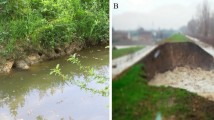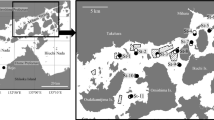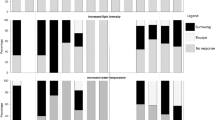Abstract
Burrowing was investigated in two Antarctic infaunal bivalve molluscs, Laternula elliptica and Yoldia eightsi, representing amongst the least and most active members of the class Bivalvia in the Southern Ocean. Burrowing rate was expressed via the Burrowing Rate Index (BRI=[3√wet weight/time to bury]×104), and produced values of 0.1–10.6 for L. elliptica and 8.8–49.8 for Y. eightsi. These compare with values ranging from 3 to 2,000 for N. American bivalves (mean=222, SE=42.6, n=81), and 200 to 2,200 for Hong Kong bivalves (mean=1,140, SE=346, n=6). Values for the Antarctic species are, therefore, low compared to warmer-water bivalves, and the values below 1 for large L. elliptica are the lowest on record by around ×5. There is no compensation of burrowing activity for low temperature in these species. The relative BRI values for L. elliptica and Y. eightsi reflect the differences in their mode of life, with the former being large, sedentary and suspension-feeding, and the latter being smaller, mobile, ploughing through the sediment and feeding on sediment-surface organic matter. Burrowing in L. elliptica is unexpected, because other members of the Laternulidae do not burrow. This ability is most probably a response to the regular disturbance of sediments in Antarctica by ice, and the strong selective advantage to being able to resume a protected position after disturbance. The burrowing cycle in L. elliptica is composed of three main phases: (1) foot extension and sediment penetration; (2) foot dilation to form an anchor; (3) the drawing down of the shell by contraction of the pedal retractor muscles. Burrowing in Y. eightsi also has three phases: (1) foot extension and penetration of the sediment (digging); (2) rocking movements in the upright position; (3) shell anchorage. In excess of burrowing activity, L. elliptica exhibits a unique suite of movements when exposed at the surface. These comprise levering, where the tips of the siphons are pressed against the sediment to lift the shell from the substratum, looping, where the siphons are extended and rotated and, in the process, translocate the whole animal across the sediment, and jetting, where water is ejected forcibly through the siphons while their tips are directed towards the sediment, lifting part or all of the animal clear of the substratum. In the field, following exhumation by icebergs, these activities serve to place the animal in a favourable position for reburial, which is a clear advantage in disturbed polar environments where predatory nemerteans and asteroids are abundant.








Similar content being viewed by others
References
Ahn I (1993) Enhanced particle flux through the biodeposition by the Antarctic suspension-feeding bivalve Laternula elliptica in Marian Cove, King George Island. J Exp Mar Biol Ecol 171:75–90
Alexander R (1993) Correlation of shape and habit with sediment grain size for selected species of the bivalve Anadara. Lethaia 26:153–162
Alexander R, Stanton R, Dodd J (1993) Influence of sediment grain size on the burrowing of bivalves: correlation with distribution and stratigraphic persistence of selected neogene clams. Palaios 8:289–303
Ansell AD (1962) Observations on burrowing in the Veneridae (Eulamellibranchia). Biol Bull 123:521–530
Ansell AD (1983) Species of Donax from Hong Kong: morphology, distribution, behaviour and metabolism. In: Morton B, Dudgeon D (eds) Proceedings of the Second International Workshop on the Malacofauna of Hong Kong and Southern China, B. Hong Kong University Press, Hong Kong, pp 19–47
Ansell AD, Peck LS (2000) Burrowing in the Antarctic anemone, Halcampoides sp., from Signy Island, Antarctica. J Exp Mar Biol Ecol 252:45–55
Ansell AD, Rhodes MC (1997) Unusual capabilities for surface movement in a normally deep-burrowed Antarctic bivalve. J Mollus Stud 63:109–111
Ansell AD, Trueman ER (1967a) Burrowing in Mercenaria mercenaria (L.) (Bivalvia, Veneridae). J Exp Biol 46:105–115
Ansell AD, Trueman ER (1967b) Observations on burrowing in Glycymeris glycymeris (L.) (Bivalvia, Arcacea). J Exp Mar Biol Ecol 1:65–75
Arntz WE, Brey T, Gallardo VA (1994) Antarctic zoobenthos. Oceanogr Mar Biol Annu Rev 32:241–304
Bailey D (2000) Muscle function characteristics in Antarctic and temperate scallops. PhD Thesis, University of St. Andrews
Berkman PA, Waller TR, Alexander, SP (1991) Unprotected larval development in the Antarctic scallop Adamussium colbecki (Mollusca: Bivalvia: Pectinidae). Antarct Sci 3:151–157
Bosch I, Beauchamp KA, Steele ME, Pearse JS (1987) Development, metamorphosis, and seasonal abundance of embryos and larvae of the Antarctic sea-urchin Sterechinus neumayeri. Biol Bull 173:126–135
Brey T, Klages M, Dahm C, Gorny M, Gutt J, Hain S, Stiller M, Arntz WE, Wagele JW, Zimmermann A (1994) Antarctic benthic diversity. Nature 368:297–298
Brockington S (2001) Ecology and physiology of S. neumayeri at Adelaide Island Antarctica. PhD Thesis, Open University, Milton Keynes
Burne R (1920) Mollusca IV. Anatomy of Pelecypoda. Br Antarct Terra Nova Exped 1910 Nat Hist Rep Zool 11:233–256
Checa AG, Cadée GC (1997a) The ligament of Mya arenaria (Myoidea) revisited. J Mar Biol Assoc UK 77:1231–1233
Checa AG, Cadée GC (1997b) Hydraulic burrowing in the bivalve Mya arenaria Linnaeus (Myoidea) and associated ligamental adaptations. J Mollus Stud 63:157–171
Clarke A, Johnston NM (1999) Scaling of metabolic rate with body mass and temperature in teleost fish. J Anim Ecol 68:893–905
Clarke A, Johnston NM (2003) Antarctic marine benthic diversity. Oceanogr Mar Biol Annu Rev 41 (in press)
Davenport J (1988) The feeding mechanism of Yoldia (=Aequiyoldia) eightsi (Couthouy). Proc R Soc Lond 282B:431–442
Davenport J (1997) Comparisons of the biology of the intertidal sub Antarctic limpets Nacella concinna and I. J Mollus Stud 63:39–48
Dell RK (1990) Antarctic mollusca. Bull R Soc NZ 27:1–311
Everson I (1977) Antarctic marine secondary production and phenomenon of cold adaptation. Philos Trans R Soc Lond 279B:55–66
Hardewig I, Peck LS, Pörtner HO (1999) Thermal sensitivity of mitochondrial function in the Antarctic Notothenioid Lepidonotothen nudifrons. J Comp Physiol B 169:597–604
Harper E, Peck LS (2003) Feeding characteristics and metabolic costs in the Antarctic muricid gastropod Trophon longstaffi. Polar Biol 26:208–217
Hoegh-Guldberg O, Pearse JA (1995) Temperature, food availability and the development of marine invertebrate larvae. Am Zool 35:415–425
Johnson TP, Bennett AF (1995) The thermal-acclimation of burst escape performance in fish—an integrated study of molecular and cellular physiology and organismal performance. J Exp Biol 198:2165–2175
Johnston IA, Johnson TP, Battram JC (1991) Low temperature limits burst swimming performance in Antarctic fish. In: diPrisco G, Maresca B, Tota B (eds) Biology of Antarctic fish. Springer, Berlin Heidelberg New York, pp 179–190
Johnston IA, Calvo J, Guderley H, Fernandez D, Palmer L (1998) Latitudinal variation in the abundance and oxidative capacities of muscle mitochondria in perciform fishes. J Exp Biol 201:1–12
McLachlan A, Young N (1982) Effects of low temperature on the burrowing rates of four sandy beach molluscs. J Exp Mar Biol Ecol 65:275–284
Morton B (1973) The biology and functional morphology of Laternula truncata (Lamarck 1818) (Bivalvia: Anomalodesmata: Pandoracea). Biol Bull 145:509–531
Morton B (1976) The structure, mode of operation and variation in form of the shell of the Laternulidae (Bivalvia: Anomalodesmata: Pandoracea). J Mollus Stud 42:261–278
Morton B (1985) Statocyst structure in the Amomalodesmata (Bivalvia). J Zool 206:23–34
Nair NB, Ansell AD (1968) Characteristics of penetration of the substratum by some marine bivalve molluscs. Proc Malacol Soc Lond 38:179–197
Pearse JS, McClintock JB, Bosch I (1991) Reproduction of Antarctic benthic marine-invertebrates—tempos, modes, and timing. Am Zool 31:65–80
Peck LS (1993) Larval development in the Antarctic nemertean Parborlasia corrugatus (Heteronemertea, Lineidae). Mar Biol 116:301–310
Peck LS (1998) Feeding, metabolism and metabolic scope in Antarctic marine ectotherms. In: Pörtner HO, Playle R (eds) Cold ocean physiology. Cambridge University Press, Cambridge, pp 365–390
Peck LS (2002a) Coping with change: stenothermy, physiological flexibility and environmental change in Antarctic seas. 4th International Conference on Comparative Physiology, La Troina, Sicily
Peck LS (2002b) Ecophysiology of Antarctic marine ectotherms: limits to life. Polar Biol 25:31–40
Peck LS, Bullough LW (1993) Growth and population-structure in the infaunal bivalve Yoldia eightsi in relation to iceberg activity at Signy Island, Antarctica. Mar Biol 117:235–241
Peck LS, Conway LZ (2000) The myth of metabolic cold adaptation: oxygen consumption in stenothermal Antarctic bivalves. In: Harper E, Crame AJ (eds) The evolutionary biology of bivalve molluscs. Cambridge University Press, Cambridge, pp 441–450
Peck LS, Robinson K (1994) Pelagic larval development in the brooding Antarctic brachiopod Liothyrella uva. Mar Biol 120:279–286
Peck LS, Colman JG, Murray AWA (2000) Growth and tissue mass cycles in the infaunal bivalve Yoldia eightsi at Signy Island, Antarctica. Polar Biol 23:420–428
Peck LS, Pörtner HO, Hardewig I (2002) Metabolic demand, oxygen supply, and critical temperatures in the Antarctic bivalve Laternula elliptica. Physiol Biochem Zool 75:123–133
Picken GB (1980) The distribution, growth and reproduction of the Antarctic limpet Nacella (Patinigera) concinna (Strebel, 1908). J Exp Mar Biol Ecol 42:71–85
Pörtner HO (2001) Climate change and temperature-dependent biogeography: oxygen limitation of thermal tolerance in animals. Naturwissenschaften 88:137–146
Pörtner HO, Hardewig I, Sartorius FJ, Van Dijk PLM (1998) Energetic aspects of cold adaptation; critical temperatures in metabolic, ionic and acid base regulation? In: Pörtner HO, Playle R (eds) Cold ocean physiology. Cambridge University Press, Cambridge, pp 88–120
Precht H, Christophersen J, Hensel H (1955) Temperatur und Leben. Springer, Berlin Heidelberg, New York
Quayle DB (1949) Movements in Venerupis (=Paphia) pullastra (Montagu). Proc Malacol Soc Lond 28:31–37
Savazzi E (1982) Adaptations to tube dwelling in the Bivalvia. Lethaia 15:275–297
Savazzi E (1990) Shell biomechanics in the bivalve Laternula. Lethaia 23:93–101
Stanley SM (1970) Shell form and life habits in the Bivalvia (Mollusca). Geol Soc Am Mem 125:1–296
Stanwell-Smith D, Peck LS (1998) Temperature and embryonic development in relation to spawning and field occurrence of larvae of three Antarctic echinoderms. Biol Bull 194:44–52
Trueman ER (1966) Bivalve molluscs: fluid dynamics of burrowing. Science 152:523–525
Trueman ER (1968) The burrowing activities of bivalves. Symp Zool Soc Lond 22:167–186
Trueman ER, Ansell AD (1969) The mechanisms of burrowing into soft subrata by marine animals. Oceanogr Mar Biol Annu Rev 7:315–366
Trueman ER, Brand AR, Davis P (1966) The dynamics of burrowing in some common littoral bivalves. Proc Malacol Soc Lond 37:97–109
Van Dijk PLM, Hardewig I, Pörtner HO (1998) Exercise in the cold: high energy turnover in Antarctic fish. In: di Prisco G, Pisano E, Clarke A (eds) Fishes of Antarctica: a biological overview. Springer, Berlin Heidelberg New York, pp 225–236
Yonge CM (1949) On the structure and adaptations of the Tellinacea, deposit-feeding Eulamellibranchia. Philos Trans R Soc Lond 234B:29–75
Yonge CM (1957) Mantle fusion in the Lamellibranchia. Pubbl Stne Zool Napoli 29:151–171
Zamorano JH, Duarte WE, Moreno CA (1986) Predation upon Laternula elliptica (Bivalvia, Anatinidae): a field manipulation in South Bay, Antarctica. Polar Biol 6:139–143
Acknowledgements
We are grateful to the Scottish Association for Marine Science, the British Antarctic Survey and the TransAntarctic Association for support for this work. We are also grateful to Rob Wood, Simon Brockington and Alice Chapman for assistance with collection of animals at Signy and Rothera.
Author information
Authors and Affiliations
Corresponding author
Rights and permissions
About this article
Cite this article
Peck, L.S., Ansell, A.D., Webb, K.E. et al. Movements and burrowing activity in the Antarctic bivalve molluscs Laternula elliptica and Yoldia eightsi . Polar Biol 27, 357–367 (2004). https://doi.org/10.1007/s00300-003-0588-7
Received:
Accepted:
Published:
Issue Date:
DOI: https://doi.org/10.1007/s00300-003-0588-7




